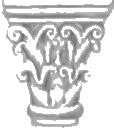 History History
There may have been a church at this site as early as the
6th
century, built on the site of Saints Fermo and Rustico's torture and
martyrdom in 304. In 765 Saint Annone, the bishop of Verona, acquired the
saints remains from Trieste, after the payment of a ransom, and placed them in this early Christian church
in a lead sarcophagus in the confessional. (They had initially been buried
in Carthage.) From 1065 to 1143 Benedictine monks
demolished the old church and built the current split Romanesque structure
- the earlier lower church to house the relics and the later upper for services.
The lower church would not originally been underground, as it is now.
Franciscans occupying the small church of San Francesco al Corso and in
need of larger premises petitioned Pope Innocent IV to allow them to move
into San Fermo. He agreed and evicted the six remaining Benedictine monks on 10 May
1249. They argued and resisted until 1260, and so it wasn't until 1261
that the complex passed to the Franciscans. They transformed the upper church,
rebuilding it in Gothic style, removing the atrium and the nave
columns to create an aisleless nave more in keeping with
their preaching needs and in layout similar to their mother church in
Assisi, which is also a double basilica. This interior work which was completed in 1350,
resulting in cycles of narrative paintings on nearly all the walls.
The
following centuries saw the addition of chapels, altars and monuments. In
1759 the remains of the martyrs were moved in their sarcophagus to the
upper church, to protect them from floods. In 1807 the Franciscans were
ejected by Napoleon and much of the complex was put to State use, with the
church passing to parish use. In 1909 buildings that concealed the
east-end chapels were removed and the lower church was opened in 1946 for
services. It is still used for services during the winter. Bombing during
WWII destroyed the cloisters but left the church largely undamaged.
Exterior
Characteristic brick and marble striped
Romanesque fašade with a more gothic lower section. To the left of the
main door is the 1350 tomb of Avantino Fracastoro, physician to the della
Scallas who died in 1368. The damaged and fragmentary frescoes from the tomb,
of the 1380s, depicting The Coronation of the Virgin were detached
in 1958 and taken to the Castelvecchio, along with their sinopie. They are attributed to the
bottega di Altichiero.
The main door has 24 bronze panels showing the lives of Saints Fermo
and Rustico made by Luciano Minguzzi in 1997. The door to the street is
14th century and framed with polychrome marble.
Interior
Inside a large aisleless Franciscan space there's a mixture of styles of
chapel and layers of frescoes from the late Middle Ages and the early
Renaissance, but the latter looking overall vivider
than elsewhere. The impressive five-lobed ship's-hull ceiling of 1314
(later than San Zeno's) was painted with
around 416 saints from 1310-1350. The design of vegetation spirals below
the ceiling level has the same date.
The (Nicol˛) Brenzoni Monument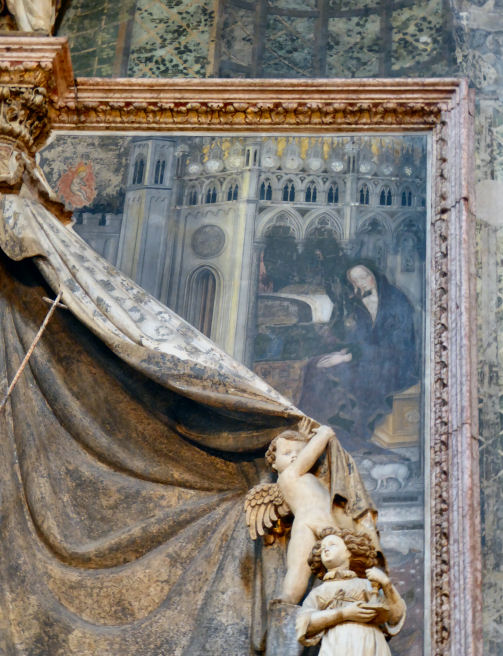 of 1426, on your left
as you enter the west door, combines sculpture of The Resurrection by Nanni di Bartolo,
a Florentine pupil of Donatello, with a fresco of The Annunciation by Pisanello.
The sculptural elements would originally have been painted and decorated
with gold leaf, and so would have merged more impressively with
Pisanello's painting. His work consists of many layers - the true fresco
base is overpainted a secco with pigments which couldn't be used in
true fresco, and there are gold molded pastiglie stars nailed on. This is his earliest surviving work, but already features
his signature wildlife. The painted figures of two more archangels, Saints Raphael and
Michael, in fictive niches above are also by him. Only three
examples of Pisanello's fresco work survive, and two are in Verona, his
mother's birthplace - the
other being at
Sant'Anastasia -
whilst his work in Mantua in the Ducal Palace is very damaged. The framing cornice of red
Verona limestone has also been gilded and painted. of 1426, on your left
as you enter the west door, combines sculpture of The Resurrection by Nanni di Bartolo,
a Florentine pupil of Donatello, with a fresco of The Annunciation by Pisanello.
The sculptural elements would originally have been painted and decorated
with gold leaf, and so would have merged more impressively with
Pisanello's painting. His work consists of many layers - the true fresco
base is overpainted a secco with pigments which couldn't be used in
true fresco, and there are gold molded pastiglie stars nailed on. This is his earliest surviving work, but already features
his signature wildlife. The painted figures of two more archangels, Saints Raphael and
Michael, in fictive niches above are also by him. Only three
examples of Pisanello's fresco work survive, and two are in Verona, his
mother's birthplace - the
other being at
Sant'Anastasia -
whilst his work in Mantua in the Ducal Palace is very damaged. The framing cornice of red
Verona limestone has also been gilded and painted.
Opposite, and further down the church,
the pulpit of white marble and red Verona limestone (1396) is by Antonio da Mestre
with framing frescoes by Martino da Verona depicting
Evangelists, Doctors of the Church, Prophets and Learned Men of Antiquity. The
altar to the right of the pulpit is 16th-century came here from the church
of Santissima TrinitÓ
in 1913.
Over the
side door (and the main door) are 14th century frescoed Crucifixions, of
different scales, by Turone di Maxio, who looks to have been an admirer of Giotto
- the one over the side door has formerly been ascribed to Cimabue and
Giotto. The frescoes on this side are relatively recent discoveries.
The chapel of the Immaculate Conception, just beyond the side
door, contains a fine altarpiece by Giovan Francesco Caroto of the Virgin and
Child and Saint Anne in Glory with Saints John the Baptist, Peter, Roch and Sebastian of 1528.
Opposite this chapel is the Capella San Bernardo. Faving you as you
enter is an altar of 1570 brought from the church of San Fermo al Ponte in
1809, with an 18th century altarpiece by Antonio Elenetti depicting
The Virgin and Child with Saints Fermo and Rustico. The chapel also
contains the early-15th-century wall tomb of Barnaba da Morano by Antonio
da Mestre, originally placed on the interior wall of the fašade. Three
panels of fresco by Martino da Verona that originally decorated the tomb
by Martino da Verona were brought here too, in 1958.
The apse is enclosed by a semi-circular screen of 1523.
Fine frescoing in the apse vault and on the surrounding arch is by an
unknown artist dubbed the Maestro del Redentore. They were formerly
attributed to Giotto, of course, and later Pisanello. One of the donors, Guglielmo da Castelbarco, can be seen on the right clutching a
representation of the church. He it was who also did much for
Sant'Anastasia, and whose famous tomb is outside the church, over the gate to the left
of the main entrance. Opposite is a matching portrait of Fra
Daniele Gusmmerio, the other founder/donor. Beneath these are a pair of scenes by Domenico
Veneziano - a very damaged Coronation of the Virgin and an
Adoration of the Magi.
To the left of the apse is the Chapel of
Saint Anthony where 14th century frescoes, once covered by whitewash, and
later canvases and panels can still be seen, as the panels have been made to
open out and fold away (see right). These Franciscan frescoes include a very Giottesque Crucifixion.
To the right of the apse is a chapel containing a fine Crucifixion by
Domenico Brucasorci.
In the right transept is the Alighieri Chapel, the
resting place of the last descendents of Dante, erected by Francesco, the
end of the male line, his daughter marrying into the Veronese Serego
family.
Leaving via the entrance doorway in the right transept
back down the staircase also allows access to the Benedictine
Lower Church, and we are
talking church - this does not feel like merely a crypt. Three rows of square
columns and pillars, support the high ceiling and there are tantalisingly faded earlier
(13th century) frescos. There are seventy frescoes, mostly saints on the square
pillars, and much decorative use of red lines and six-petalled flowers (see
right),
found during restoration in 2005. The latter are ancient sacred symbols,
called Flowers of Life, and are said here to be symbolic of Christ's resurrection. The penultimate column in the right
aisle has an inscription which gives us the date of the start of building
as 1065.
allows access to the Benedictine
Lower Church, and we are
talking church - this does not feel like merely a crypt. Three rows of square
columns and pillars, support the high ceiling and there are tantalisingly faded earlier
(13th century) frescos. There are seventy frescoes, mostly saints on the square
pillars, and much decorative use of red lines and six-petalled flowers (see
right),
found during restoration in 2005. The latter are ancient sacred symbols,
called Flowers of Life, and are said here to be symbolic of Christ's resurrection. The penultimate column in the right
aisle has an inscription which gives us the date of the start of building
as 1065.
Romeo and Juliet connection
According to Shakespeare's play and the original
story by Matteo Bandello the Lower Church is where Romeo and Juliet
died.
Campanile
Begun by the Benedictines but not completed until the 13th
century.
Lost art
A still partially-polychromed statue of
Saint Martha, a Saint John the Baptist and a Swooning
Virgin Mary, all three by the Master of Sant'Anastasia from the first
half of the 14th century are in the Castelvecchio.
Painted for Altabella Avogaro Dal Bavo, the Virgin and Child with
Saints Onuphrius, Jerome, Donato and Christopher,
known as the Dal Bavo Altarpiece 1484 by Francesco Bonsignori,
which was in the family chapel here, has been in
the Castelvecchio since 1881.
A Nativity with Saint Jerome by Liberale da Verona,
once in the second sacristy here, is now
in the Castelvecchio.
Veronese's first altarpiece, a Virgin and Child with Saints John the Baptist and Louis and two
donors (the Bevilacqua Lazise Altarpiece, see right) painted when he was 18,
hung in a chapel here commissioned in 1544 by Lucrezia Malespina in memory of
her husband Giovanni Bevilacqua Lazise, the donors depicted, but
was transferred to the Castelvecchio in 1865 following the demolition of
the chapel.
The sculptor Andrea Riccio from Padua made a tomb
for Girolamo della Torre and his son Marcantonio, two
physician-professors, in this church between 1516 and 1521. Its eight
bronze reliefs of pagan scenes are now in the Louvre.
Opening times
Monday-Saturday 9.30 - 6.00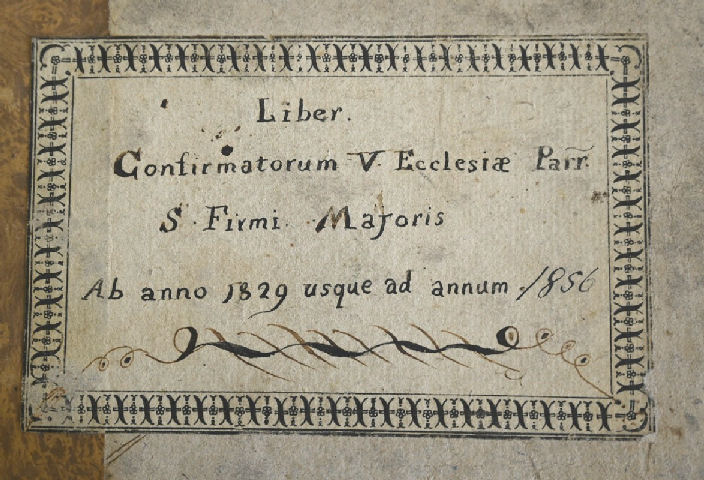
Sunday and holidays: 1.00 - 6.00
(November-February
Monday-Friday 10.00 - 5.00
Saturday 10.00 - 5.30
Sunday and holidays: 1.00 - 5.30)
One of the four churches run by Associazione Chiese Vive
www.chieseverona.it
who in January 2023 published a new guidebook for
this church, in Italian, English, French and German.
|
|
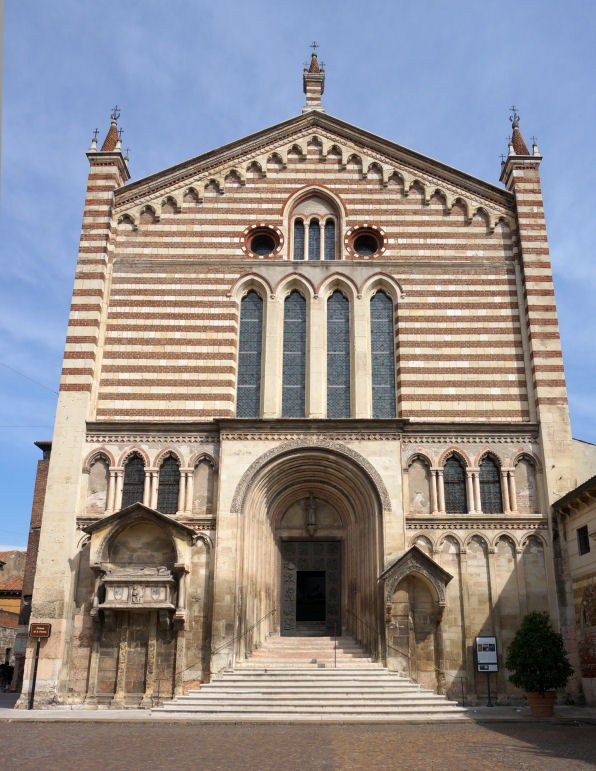



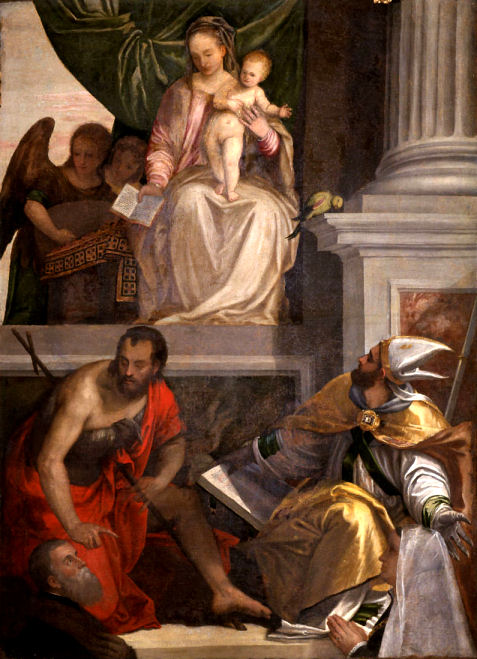
|
 History
History